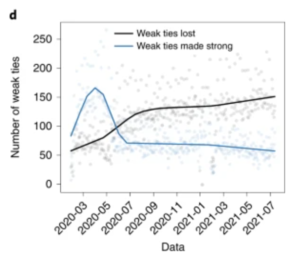In a post-lockdown world, some employers are giving their employees the option to stay remote, work in-person, or hybrid; some are mandating in-person. Perhaps they are justified.
Introduction
We learned in class about Mark Granovetter’s research (1973) on strong and weak ties where he proposes that weak ties enable the spread of information and ideas and are very influential for social and job mobility. Weak ties will give you access to different parts of a network while strong ties will leave you in the same cluster/group. Being in different parts of a network can potentially give you access to new information, while staying in the same cluster will give you redundant information. As emphasized in class, this theory was extrapolated to job networks: Weak ties are more beneficial to finding a new job than strong ties.
Research
This theory was also extrapolated to the workplace in Carmody et al.,’s (2022) research paper. Sociologists have speculated that the lack of connections made during the pandemic negatively caused the decline of innovation and creativity. Researchers at MIT and help from colleagues at Texas A&M University, Italian National Research Council, Technical University of Denmark, and Oxford University analyzed the network structure of the MIT email network of research staff, faculty, and postdoctoral researchers before the pandemic, during the pandemic, and after the pandemic.
Analysis
During analysis, it was noted that at the start of the pandemic that emails between different research units dropped. This is a clear indicator that the number of weak ties had fallen. It is relevant to note that local bridges are a proxy for weak ties.

Another relation that researchers observed is weak-tie formation and physical proximity. Researchers took the distances of office locations to account. They compared the number of weak ties, pre and post pandemic, formed by those in close proximity. They saw a significant and immediate drop of the number of weak ties with those who had offices close-by to each other while there was no significant drop in weak ties with those who had offices far away from each other.
Post-pandemic data refers to the data gathered during the reopening of MIT when research labs were recommended to adopt a hybrid work schedule. Employees were recommended to come in 3 of the 5 days of the week, and social distancing restrictions were still in place. Although it was found that the number of weak ties increased significantly in the beginning, the overall number of weak ties is still lower than what it was pre-pandemic (proximity results are the same). Overall, a hybrid work model was successful in increasing the amount of weak ties, but not as much as a fully in-person work model.
Conclusion
With the rise of remote and hybrid workplaces, it seems like there is no good reason to go back fully in-person anymore. But with this study, as an employer, this is a motivation to push for more in-person events in hopes of an improvement on innovation. This is also useful if you become a future manager or CEO as it shows that you should promote in-person workplaces. This is also useful if you want to find (or are finding) a job. Although a remote job has its many benefits, consider an in-person or hybrid workplace for its subtle benefits. Perhaps your next promotion could be initiated through the creativity and innovation fostered by meeting new friends at work.
tldr;
- (as learned in class) weak ties are good for networking and passing on ideas and information across networks
- weak ties has an impact on innovation and creativity
- decline in weak ties during pandemic
- proximity is good for fostering weak ties
- hybrid is okay at fostering weak ties, but can do better
- takeaway:
- proximity increases the number of weak ties, which increases innovation and creativity.
- think about this this when you’re considering a remote job or want to foster an innovative workplace
Sources
One reply on “Are Remote Jobs Really the Best?”
Could defintely see how inperson produces more weak ties as with remote it’s kinda harder to get involved with other teams if they don’t directly affect your job. I definitely think that the pros of remote work will out weigh doing in-person but having hybrid is a best of both worlds, so likely that will be the new standard for office work.